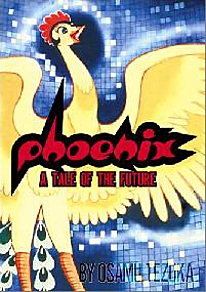Review
by Mike Crandol,Phoenix: A Tale of the Future
(manga)
| Synopsis: |  |
||
3404 A.D.: Earths' surface has become uninhabitable, and the expanse of human civilization has been reduced to a mere five underground cities. Though mankind has flourished in these subterranean capitals, a yearning for the planet's former beauty and splendor remains. Enter the Moopies, shape-shifting creatures with the ability to induce an hypnotic state in humans which brings visions of earth's past to life. More addicting than the most lethal drugs, the Moopies' talents have caused their race to be hunted to the brink of extinction by the government. But Space Patrolman Masato Yamanobe secretly protects the last Moopie, who has taken the form of a human woman named Tamani. Meanwhile, on the surface, the hermit scientist Dr. Saruta seeks a way to breath life back into the barren, desolate world. Fate soon draws this unlikely trio together, and the seeds are sewn for the promised rebirth. |
|||
| Review: | |||
Though better known in the U.S. for Astro Boy and Kimba the White Lion, the "Phoenix" cycle is manga god Osamu Tezuka's life's work. An anthology of stories spanning from the dawn of civilization to the distant future, Tezuka wrote various Phoenix manga from 1954 until his death in 1989. "Tale of the Future" dates from 1967, and it's technologically advanced world populated by robots and mad scientists is most like Astro Boy's and thus more recognizably Tezuka's to American fans. "Phoenix" is a prime example of why Tezuka is internationally recognized as one of the greatest comics artists in history, as well as the primary architect of the anime medium. Previously, the manga form had been mostly limited to brief one-note jokes comparable to American newspaper comic strips. Tezuka popularized longer, serialized stories with fully-developed plotlines, more in keeping with American comic books. But whereas U.S. comics were almost exclusively the realm of cape-wearing superheroes, Tezuka's varying tastes insured that manga would become a popular medium for all sorts of fiction in every genre conceivable. "Phoenix" is classic Tezuka: an intelligent and involving moral parable with universal appeal. He would also bring these same qualities to the embryonic anime industry in his many pioneering animated series and feature films, establishing a standard to which all anime that followed would be measured. His drawing style is also something rare and wonderful. Strongly influenced by the work of Disney and other early American animation studios, his characters possess a unique look in which one can see the beginnings of "anime style"(big glossy eyes, pointy hair, tiny mouth); yet at the same time it would not be out-of-place in a classic Hollywood cartoon. Indeed, the denizens of "Phoenix" would blend nicely into a 1930's Max Fleischer "Popeye" or "Betty Boop" picture. But instead of a short, simple, gag-laden story, "Phoenix" is grand sci-fi adventure tale with very little in the way of humor. It is to Tezuka's immense credit that he is able to craft such a convincing, serious epic with such classically cartoony-looking characters. In the hands of a lesser artist the caricatured nature of the artwork could easily undermine the straightforward tone of the story. Tezuka's superb visual style carries it all with ease, and challenges our preconceptions of the kinds of stories "cartoon characters" can tell. Tezuka's manga share similarities with the work of the American comics master Carl Barks, whose "Uncle Scrooge" also told sprawling, epic adventures drawn in the style of old Hollywood cartoons. But Tezuka's stories tend to be more topical, sophisticated, and complex, and often raise moral and ethical questions in the process. When his superior discovers he is harboring a Moopie, Yamanobe is ordered to kill Tamani, who has become as close to him as a wife, and for a while he seriously considers it. The reasons behind the government's ban on Moopies is a thinly veiled jab at the Japanese social conscious of the 1950s and 60s, which was torn between nostalgia for a lost past and a runaway modernization of the country. And Dr. Saruta's animal creations, which can only live inside the glass tubes they were grown in, pose interesting questions about the nature and value of life. All of these rather heavy themes are presented in a very straightforward, easy-to-understand manner, another strength of Tezuka's work. Though a child would likely miss the social commentary and metaphor, "Phoenix's" concepts of Moopie mind-games and the disadvantages of a government controlled (literally) by machines are related in simple terms the young can easily understand. This is not to say that "Phoenix" is a children's story by any stretch of the imagination; like the works of Hayao Miyazaki and the better Disney films, "Phoenix" and many other of Tezuka's creations are just as (if not more) enjoyable for adults than for their kids. Tezuka consistently provides proof that there is no such thing as a good "Children's Story".....there are only Good Stories. Anime and manga fans who are unfamiliar with the work of the genres' most significant pioneer will find in "Phoenix: A Tale of the Future" all of the qualities that made the name Osamu Tezuka legendary. A thoughtful and provoking moral parable, packed with action and imagination, populated with cartoonish yet remarkably human characters, "Phoenix" is vintage manga as only the Master could create. |
|
The views and opinions expressed in this article are solely those of the author(s) and do not necessarily represent the views of Anime News Network, its employees, owners, or sponsors.
|
| Grade: | |||
|
Overall (dub) : A+
Story : A+
Art : A+
+ wonderful "golden age" artwork tells an exciting sci-fi adventure story with a point |
|||
| Production Info: | ||
|
Full encyclopedia details about |
||